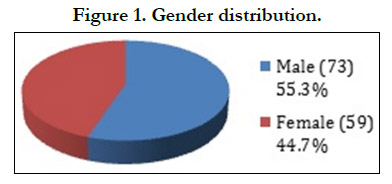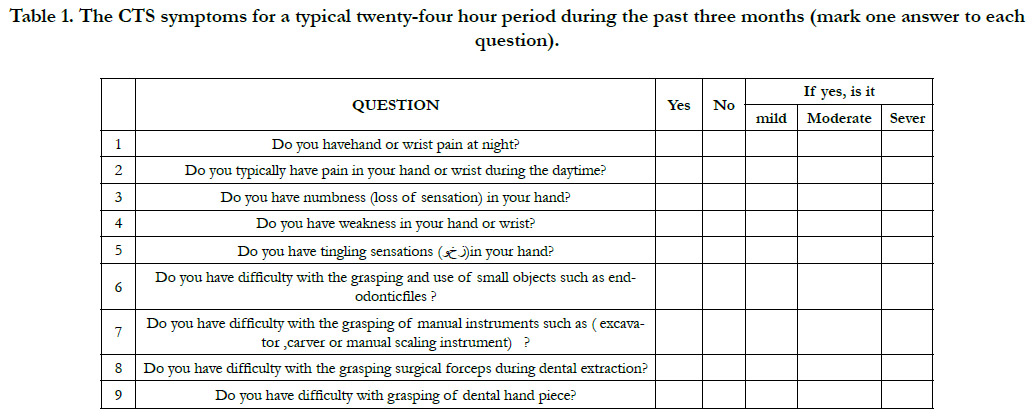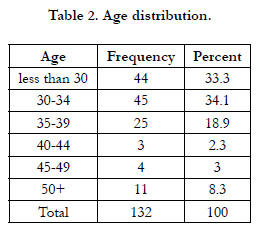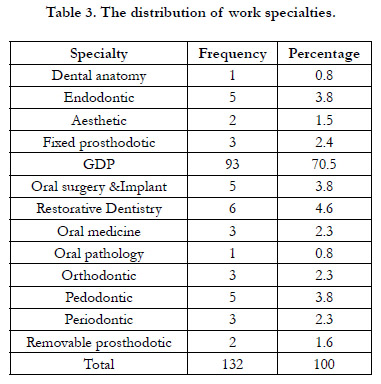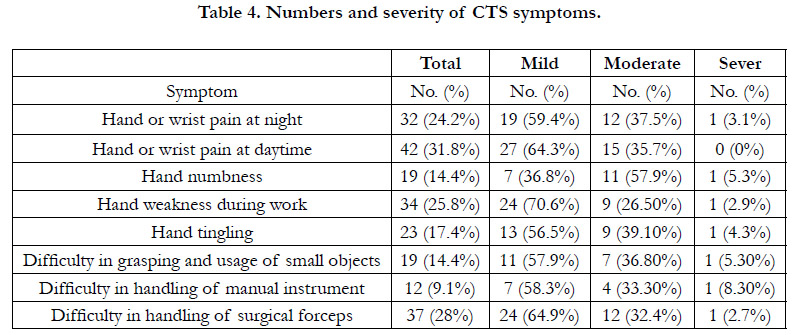Prevalence of Carpal Tunnel Syndrome Symptoms Among Dentists in Benghazi City - Libya
Abdelmonem Ali Abdelnabi1*, Rafeeq Mohammed Al Kuwafi2, Khadeejah Abdulsalam Hashim3, Marwa Ahmed Bugedar4
1 Assistant lecturer at Preventive and community dentistry Department, Head of child dental care department at Libyan International Medical University,
Libya.
2 German Board Of Oral And Maxillofacial Surgery, Doctoral Degree By LBMS, Lecturer at Oral and maxillofacial department, Vice Dean at Libyan International Medical University, Libya.
3 General Dental Practitioner at Libyan International Medical University, Libya.
4 General Dental Practitioner at Libyan International Medical University, Libya.
*Corresponding Author
Abdelmonem Ali Abdelnabi,
Assistant lecturer at Preventive and community dentistry Department, Head of child dental care department at Libyan International Medical University, Libya.
Tel: 00218927980791
E-mail: Abdelmonem.ast@gmail.com/Abdelmonem@limu.edu.ly
Received: June 22, 2021; Accepted: November 07, 2021; Published: November 10, 2021
Citation: Abdelmonem Ali Abdelnabi, Rafeeq Mohammed Al Kuwafi, Khadeejah Abdulsalam Hashim, Marwa Ahmed Bugedar. Prevalence of Carpal Tunnel Syndrome Symptoms
Among Dentists in Benghazi City - Libya Int J Dentistry Oral Sci. 2021;8(11):4939-4942. doi: dx.doi.org/10.19070/2377-8075-21000998
Copyright: Abdelmonem Ali Abdelnabi©2021. This is an open-access article distributed under the terms of the Creative Commons Attribution License, which permits unrestricted use, distribution and reproduction in any medium, provided the original author and source are credited.
Abstract
Introduction: Many diseases may affect the nerves of a wrist. One of them is Carpal Tunnel Syndrome (CTS). It is defined
as “A painful disorder in the wrist and a hand that is caused by compression of the median nerve within the carpal tunnel of
the wrist”. In the general population the frequency of CTS prevalence ranged between 3% and 6%.
Objectives: To demonstrate the prevalence of CTS symptoms among dentists who working in Benghazi city -Libya.
Methods: A cross sectional study conducted in Benghazi - Libya in 2019. 205 dentists worked in 14 deferent dental clinics
across the city were included. They were required to fill in a questionnaire regarding the symptoms of CTS.
Results:Out of 205 questionnaires were distributed, only 132dentists (64.4 %) were responded. Of those 132 dentists, 73
were male (55.3%) and 59 (44.7%) were female. The results of the study shows that 32 dentists (24.2%) of the total participating
experienced hand or wrist pain has been at night, whereas 42 dentists (31.8%) complained about hand or wrist pain at
daytime. In addition, 19 dentists (14.4%) of them felt hand numbness and 34 (25.8%) suffered from hand weakness during
work. Moreover, hand tingling problems were observed in 23 dentists (17.4%), and the difficulty with grasping and using
small objects were reported in 19 dentists (14.4%). Finally, the difficulty of handling manual devices and surgical forceps was
detected in 12 dentists (9.1%) and 37 dentists (28%) respectively.
Conclusion: This study shows a significant number of dentists who have symptoms of Carpal Tunnel Syndrome.
2.Introduction
3.Materials and Methods
3.Results
4.Discussion
5.Conclusion
5.References
Abbreviations
CTS: Carpel Tunnel Syndrome; GDP: General Dental Practitioners.
Introduction
One of the most common peripheral neuropathy of the median
nerve is carpel tunnel syndrome (CTS).[1] It is a compression to
the median nerve that characterized generally by different symptoms
such as pain, numbness, and paresthesia. These symptoms
occur in the area supplied by the median nerve such as thumb,
index, and middle fingers, in addition to the lateral half of the
ring finger.[2] The main cause of this syndrome is unknown, but
it could be a consequences of median nerve vein circulatory disorder
and increasing internal canal pressure which indeed results
in ischemia to the median nerve. Moreover, it may take place due
to tenosynovitis of the tendons that close to the median nerve.
[3] In addition, wrist bone fracture or dislocation, connective tissue
disorder, obesity, pregnancy, infections, and metabolic disease
may also lead to this syndrome.[2]
However, among the general population, the prevalence of CTS
are ranged between 3% and 6%,[4] while among pregnant women
it reaches 19%,[5] whereas among diabetic patients it reaches up
to 20%.[6] The working population has showed more prevalence
of this syndrome than the non-working population. Occupationally,
this syndrome happens frequently with the jobs that include
chronic bending movements of the wrist during forceful catching of devices.[4] Practicing dentistry is one of these jobs, which
include repetitive twisting of the wrist especially during manual
dental root canal treatment, scaling, tooth preparation, and extraction.
Among dental practitioners, the commonness of CTS
symptoms in Karachi city of Pakistan, is 10.31%,[7] while in Riyadh
city of Saudi Arabia it almost 30.5%.[4] In Libya, the prevalence
of this syndrome among dental practitioners has not yet
been known. Therefore, the aim of this study is to demonstrate
the prevalence of CTS symptoms among dentists who work in
Benghazi.
Materials And Methods
A cross-sectional study was conducted in Benghazi – Libya in
2019.A total of 205 dentists from 14 different polyclinics and private
dental clinics were included. Those participants were asked to
answer a questionnaire regarding CTS.
A two parts of self-administrated questionnaire was used. The
socio-demographic data was included in the first part of the questionnaire,
which include questions related to age, gender, years
of experience, degree level, specialty, working time and medical
condition. The second part of the questionnaire include nine different
questions related to the symptoms of CTS and its severityas
seen in Table 1. All data were analyzed by using IBM SPSS
software version 22.
Results
Out of 205 questioners were distributed, only 132 dentists (64.4
%) responded, with a dropout rate of 73 dentists (35.6 %). Regarding
gender,73 dentists (55.3%) were male and 59 dentists
(44.7%) were female (Figure 1). The highest number of participants
45 dentists (34.1%) was in the age group 30 – 34 years old
and 44 dentists (33.3%) was in the age group less than 30 years
old, whereas the lowest number of participants3 dentists (2.3%)
was in the age group 40 – 44 years old (Table 2). 52 dentists
(39.4%) have less than five years work experience, while 35 dentists
(26.5%) have an 5-to-10 work experience. Moreover, 26 dentists
(19.7%) and 19 dentists (14.4%) were reported to have 10 to
15 years of experience and = 15 years of experience respectively.
Regarding medical condition of participants, 5 dentists (3.8%)
were reported to have type II diabetes mellitus, 2 dentists (1.5%)
have hypothyroidism and 2 dentists (1.5%) have hypertension.
However, no one seemed to suffer from rheumatoid arthritis
or other joint diseases. In relation to pregnancy, only 3 dentists
(2.3%) were pregnant.
It was found that 94 dentists (71.2%)of the participants were
graduated dentists, 31 dentists (23.5%) have master degree and
only 7 dentists (5.3%) have a PhD degree. The highest percentage
of the participants 93 dentists(70.5%) work as a general dental
practitioner (GDP), while the other participants were distributed
among other work specialties (Table 3).
It was found that 32 dentists (24.2%) of the total participants experienced
hand or wrist pain at night, in which the severity of the
pain was distributed into 19 dentists (59.4%), 12 dentists (37.5%),
and 1 dentists (3.1%) for mild, moderate and severe pain respectively.
Nevertheless, the percentage of dentists' ages who complained
about hand or wrist pain at daytime were more than that
at night with 42 dentists (31.8%) and 32 dentists (24.2%). Some
of them 27 dentists (64.3%) complained about mild pain and 15
dentists (35.7 %) had moderate pain, while there was no severe
pain reported meanwhile during daytime. In addition, 19 dentists
(14.4%) of the total participants showed that they suffered from
numbness that were classified into 36.8% for mild, 57.9% for
moderate, and 5.3% for severe form of hand numbness.
Moreover, 34 dentists (25.8%) were reported the symptom of
hand weakness during work. The majority of them 24 dentists (70.6%) were reported with mild form of hand weakness. Moreover,
the hand tingling was reported by 23 dentists (17.4%) (Table
4).
However, 19 dentists (14.4%) reported to have the difficulty with
grasping and handling of small objects. Finally, the difficulty in
handling of manual instruments and surgical forceps recorded by
12 dentists (9.1%) and 37 dentists (28%) respectively (Table 4).
Table 1. The CTS symptoms for a typical twenty-four hour period during the past three months (mark one answer to each question).
Discussion
This cross sectional study evaluated the median nerve neuropathy
among 132 dentists with different ages, years of working experience
and work specialities.
Occupational musculo-skeletal complains in dentistry usually occurs
with upper body movements in sitting or standing positions
during dental work.[8, 9]
A considerable proportion of the participants 81 dentists (61.3
%) had one or more symptoms of CTS. This was much higher
than other studies with similar aim like Karachi study (10.3%),[7]
Riyadh study (30.5%),[4] Isfahanian study (16.7%),[2] Shiraz
study (17.5%),[10] Chennai study (25.7%),[11] United States army dentists study(28%),[12] Australian study (34%).[13] Malaysian
study 21.2%, [14] and Lahore study (15.5%).[15] The explanation
of this could be due to lack of knowledge about CTS and how it
could be prevented as CTS was not taught during undergraduate
and even in postgraduate years, also considerable proportion of
the participants 60 dentists (45.5%) were working full time which
can attribute to development of CTS.
60 dentists (75 %) with CTS symptoms were working as general
dental practitioner (GDP) and that can explained by the large
number of GDP participants in this study. In regarding to dental
speciality and CTS, it was found that 4 endodontists (80%), 3 periodontists
(100%), 3 pedodontists (60%) and 4 restorative dentists
(66.6%) had CTS symptoms, similar results were found in other
studies like Karachi study, [7] Riyadh study, [4] and Chennai study.
[11] Gender distribution of dentists with symptoms of CTS was
43 female dentist (53%) and 38 male dentist (47%). Female dentist
was slightly found to be more prone to CTS than male dentist
and this tendency could be due to smaller wrists and potentially
smaller carpel tunnel volume.[16]
Unlike other studies, [17] the symptoms of pain related to CTS
were more during daytime than that of nighttimes, the explanation
of that could be attributed to rest movement during dental
work which increases the compression of the median nerve as it
passes through the carpal tunnel.
Conclusions
This study shows a significant number of dentists who may havea
Carpal Tunnel Syndrome in the city of Benghazi. General dental
practitioners, endodontists, periodontists and pedodontist are
more prone to CTS. It is, therefore, important to draw a serious
attention to CTS and its risk factors. In addition, to increase the
awareness and knowledge about CTS among dental students and
working dentists. Further studies include larger sample size and
more different cities across Libya should be conducted.
Clinical Significance
This paper demonstrates the relationship of Carpal tunnel syndrome
among dentists as an occupation that requires wrist movement
and bending which is a significant cause of the syndrome.
References
-
[1]. Aroori S, Spence RA. Carpal tunnel syndrome. Ulster Med J. 2008
Jan;77(1):6-17. PubMed PMID: 18269111.
[2]. Haghighat A, Khosrawi S, Kelishadi A, Sajadieh S, Badrian H. Prevalence of clinical findings of carpal tunnel syndrome in Isfahanian dentists. Adv Biomed Res. 2012;1:13. PubMed PMID: 23210072.
[3]. Bland JD. Carpal tunnel syndrome. BMJ. 2007 Aug 18;335(7615):343-6. PubMed PMID: 17703044.
[4]. Alhusain FA, Almohrij M, Althukeir F, Alshater A, Alghamdi B, Masuadi E, Basudan A. Prevalence of carpal tunnel syndrome symptoms among dentists working in Riyadh. Ann Saudi Med. 2019 Mar-Apr;39(2):104-111. Pub- Med PMID: 30905925.
[5]. Khosrawi S, Maghrouri R. The prevalence and severity of carpal tunnel syndrome during pregnancy. Adv Biomed Res. 2012;1:43. PubMed PMID: 23326774.
[6]. Oktayoglu P, Nas K, Kilinç F, Tasdemir N, Bozkurt M, Yildiz I. Assessment of the Presence of Carpal Tunnel Syndrome in Patients with Diabetes Mellitus, Hypothyroidism and Acromegaly. J ClinDiagn Res. 2015 Jun;9(6):OC14-8. PubMed PMID: 26266148.
[7]. Ahmed A, Khan A, Siddiqui Z, AHMED MR, Askari H, Zahid A. Prevalence of carpel tunnel syndrome in the dentists working in Karachi. Pakistan Oral & Dental Journal. 2014 Dec 1;34(4).
[8]. Chin DH, Jones NF. Repetitive motion hand disorders. J Calif Dent Assoc. 2002 Feb;30(2):149-60. PubMed PMID: 11883427.
[9]. Brown PN. What's ailing us? Prevalence and type of long-term disabilities among an insured cohort of orthodontists. Am J OrthodDentofacialOrthop. 2004 Jan;125(1):3-7. PubMed PMID: 14718873.
[10]. BorhanHaghighi A, Khosropanah H, Vahidnia F, Esmailzadeh S, Emami Z. Association of dental practice as a risk factor in the development of carpal tunnel syndrome. J Dent (Shiraz). 2013 Mar;14(1):37-40. PubMed PMID: 24724115.
[11]. Inbasekaran D, Sankari M, Nambi SG. Prevalence of carpal tunnel syndrome among dentists in Chennai, India. Drug Invention Today. 2018 Nov 2;10(3):3262-5.
[12]. Lalumandier JA, McPhee SD. Prevalence and risk factors of hand problems and carpal tunnel syndrome among dental hygienists. J Dent Hyg. PubMed PMID: 11475758.
[13]. Leggat PA, Kedjarune U, Smith DR. Occupational health problems in modern dentistry: a review. Ind Health. 2007 Oct;45(5):611-21. PubMed PMID: 18057804.
[14]. Munirah MA, Normastura AR, Azizah Y, Aziah D. Prevalence of probable carpal tunnel syndrome and its associated factors among dentists in Kelantan. International Journal of Collaborative Research on Internal Medicine & Public Health. 2014;6(8).
[15]. Ehsan M, Ehsan S, Arshad H. Frequency of carpal tunnel syndrome in dentists working in government hospitals of lahore. Int J Sci Res. 2013;14:2319- 7064.
[16]. SayeghGhoussoub M, Ghoussoub K, Moucharrafieh L, Khoury A, Sleilaty G, Rifaď K. Troubles musculo-squelettiques chez une population de chirurgiens- dentisteslibanais: Fréquence et facteurs de risque [Musculo-skeletal problems among Lebanese dental surgeons. Occurrence and risk factors]. J Med Liban. 2005 Jan-Mar;53(1):21-7. PubMed PMID: 16398209.
[17]. Šošic L, Bojnec V, Lonzaric D, JesenšekPapež B. An advanced stage of carpal tunnel syndrome - is night-time splinting still effective? Int J Occup Med Environ Health. 2020 Oct 20;33(6):771-780. PubMed PMID: 32929289.

